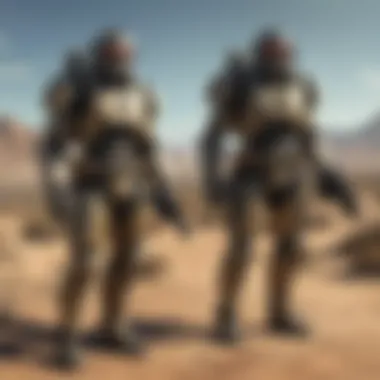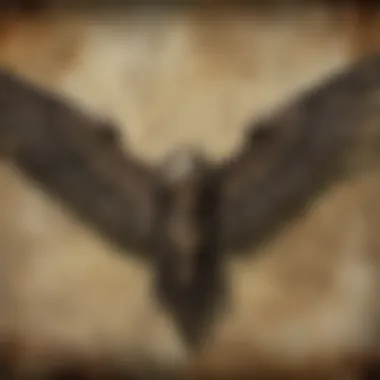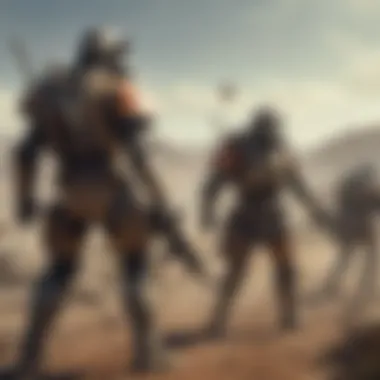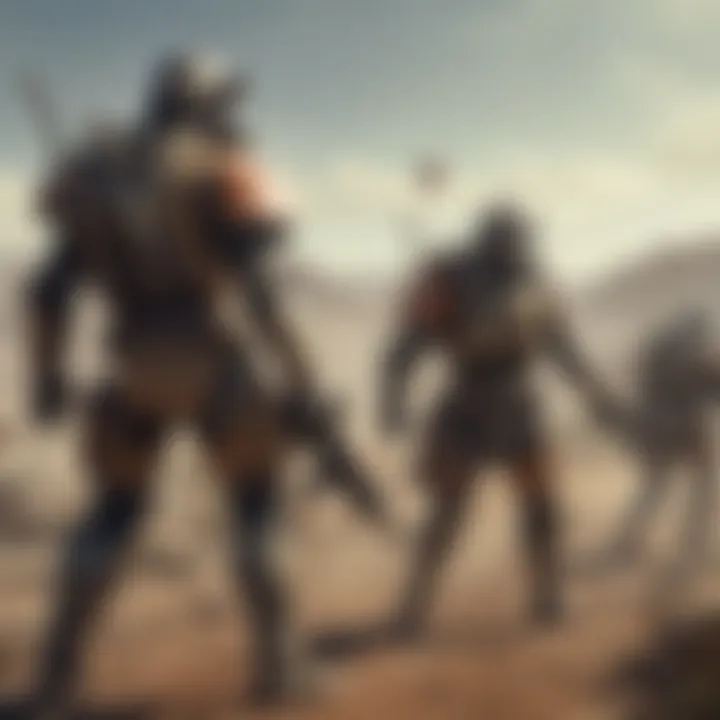Cazadores: Their Impact and Role in Fallout


Intro
Cazadores are one of the more fearsome and recognizable foes within the vast landscape of the Fallout universe. These monstrous insects, with their striking wings and venomous stingers, don't just serve as a test of skill for players; they also embody the emerging themes of environmental adaptation and survival in a post-apocalyptic world. In this article, we will delve into their biological underpinnings, behavioral adaptations, and their influence on the broader Fallout narrative.
Lore Insights
Overview of the Fallout Universe
The Fallout series, known for its intricate storytelling and rich lore, takes place in a retro-futuristic world that collided with nuclear disaster. After a catastrophic event, society crumbled, and the remnants of humanity must navigate the ruins of civilization. In this desolate setting, life forms evolved desperately to cope with new realities, and the cazador is a prime example of such adaptations.
Cazadores perfectly illustrate how nuclear fallout redefined life itself, merging biology with the consequences of mankind’s decisions.
Key Historical Events in the Fallout Timeline
Throughout the Fallout timeline, several key events led to the emergence of the cazador. Most prominently, the Great War in 2077 unleashed devastation which irrevocably altered habitats and ecosystems. Bugs and creatures mutated drastically as they sought refuge in an irradiated landscape, resulting in the creation of the cazador species. These creatures thrive where other life forms struggle, underscoring the harsh reality of survival.
Deep Dive into the Backstory of Major Factions and Characters
The cazadores find their niche primarily in regions like the Mojave Wasteland, often crossing paths with factions such as the NCR and Caesar's Legion. Their aggressive nature has made them notorious among both seasoned and novice players. Encountering cazadores is akin to stumbling upon an ambush; their lightning-fast movements and potent stinging attacks create an ever-present threat.
Despite being primarily pests, cazadores do have a historical encounter with significant characters. For instance, in "Fallout: New Vegas", the player's interactions with various factions often bring them into direct contact with these ferocious insects, impacting quests and survival strategies.
Gameplay Tips and Strategies
Beginner's Guide to Playing Fallout Games
For newcomers to Fallout, understanding the environment and key enemy encounters is crucial. Cazadores serve as a milestone in your gameplay journey. Begin by familiarizing yourself with their attack patterns and preferred habitats, as this knowledge is key to survival.
Weapon and Armor Recommendations
To combat cazadores effectively, players should equip themselves with weapons that have a reliable rate of fire. Recommended options include:
- Rifles: The Varmint Rifle holds decent power and accuracy.
- Shotguns: Perfect for close encounters, offering high damage potential.
In terms of armor, prioritize lightweight gear that provides decent protection while allowing for swift movement.
Tips for Efficient Resource Management
While battling cazadores, always keep an eye on your supplies. Stock up on health items and consider crafting antidotes if vulnerable to their venom. Learning how to make the most of your resources can mean the difference between life and death.
Character Analysis
Detailed Profiles of Iconic Characters
While cazadores do not have individual profiles like human characters, they influence player interactions with several iconic figures in the game. Understanding this dynamic can enhance gameplay.
Relationships Between Characters in the Fallout Series
The relationship between factions like the NCR and cazadores varies based on the overarching narrative choices made by the player, affecting alliances and hostilities within the game.
Character Development and Evolution Across Games
As players progress through different Fallout installments, they may notice how creatures like cazadores remain consistent threats or evolve ever so slightly, prompting different strategies to take them down.
News and Updates
Latest Announcements from Game Developers
Keeping up with the Fallout community via platforms like Reddit can help players stay informed about any adjustments made to cazadores in patches or updates.
Patch Notes and Upcoming Releases
Any changes to cazadores would be noted in patch notes, often highlighting balancing adjustments to how they function in gameplay.
Community Events and Tournaments
Community events might also feature challenges involving cazadores, providing a unique way to test skills against these formidable foes.


Fan Theories and Speculations
Popular Fan Theories About the Fallout Universe
Several theories circulate about the origins of cazadores, with players speculating on their precise development during the pre-war era.
Discussion on Unresolved Plot Points
The recurring appearances of cazadores prompt questions about their survival and role in the ecosystem. Players often ponder how their existence correlates with larger narrative threads within the Fallout series.
Predictions for Future Installments in the Series
As Fallout continues, players anticipate potential evolutions or revelations about cazadores, adding depth to their lore and gameplay mechanics.
By exploring the cazadores in-depth, we gain insights that reveal far more than just a creature to conquer but a lens through which the Fallout universe's themes of survival, adaptation, and the consequences of pre-war actions come to life.
Foreword to Cazadores
In the sprawling and often chaotic world of the Fallout universe, creatures play a pivotal role in shaping the player's experience. Among these entities, the cazadores stand out as unique and dangerous foes. Understanding the significance of these creatures not only enhances gameplay but also enriches the overall narrative woven throughout the series. With their striking characteristics and distinctive behaviors, cazadores embody the merging of nature and mutation in the post-apocalyptic landscape.
Delving into the specifics about their identity and lore reveals a lot about how danger is depicted in Fallout and the implications it has for survival. In the harsh and unforgiving environments that players navigate, cazadores serve as constant reminders of the threats that emerge from humanity's neglect of nature. This section seeks to unpack the essence of cazadores, examining their origins, traits, and roles in the larger fabric of Fallout lore.
Defining Cazadores
Cazadores are a hybrid of insect and animal features, sprung from the remnants of the world after nuclear fallout altered countless species. Physically, they possess characteristics of both wasps and other predatory creatures, creating an unsettling appearance. Their foreboding wings, sharp, venomous stingers, and relentless speed make them formidable opponents. Players quickly learn that encounters with these creatures often result in peril.
Though classified as mutated insects, labelling cazadores merely as pests would be a gross understatement. They function as apex predators in their environment, showcasing evolutionary adaptations that enhance their predatory nature. Their intricate design, a fusion of beauty and horror, serves as a stark reminder of the unpredictable outcomes of a world altered by radiation.
Cazadores in the Fallout Lore
The lore surrounding cazadores stretches beyond their immediate danger in gameplay. Originating from the wasteland's corrupted ecosystem, they encapsulate the tragic narrative of how life struggles to persist amid decay. Cazadores are often found in the Mojave Desert, a setting lush with life but marred by violence.
These creatures have become symbols of the changes inflicted upon the world, appearing in various locales and contexts that underscore the fragility of nature. Their roles in the storyline serve to amplify the overarching themes of survival and adaptation, prompting players to confront the errors of the past. In the grand scheme of Fallout lore, cazadores come to represent the aftermath of blindsided progress, a fusion of beauty amidst the chaos, urging players to not only combat them but also reflect on the greater narrative the game conveys.
"Cazadores are not just foes, but embodiments of the devastating impact of humanity's actions on the natural world, compelling players to recognize the importance of preservation in a ravaged landscape."
So as we venture deeper into the world of cazadores, we’ll uncover their biology, behaviors, and interactions, shaping our understanding of these intriguing yet fearsome beings in the Fallout universe.
Biological Characteristics of Cazadores
Understanding the biological characteristics of cazadores is crucial, as it not only sheds light on their role within the Fallout universe but also exemplifies the intricate design of creatures that interact with the environment and players alike. From their anatomy to how they reproduce, these elements reveal much about their adaptation to the harsh realities of the Wasteland.
Anatomy and Physiology
Cazadores are truly a sight to behold. Imagine a grotesque blend of insect and creature, these beasts are characterized by their long, slender bodies and large, membranous wings. Their exoskeleton, reminiscent of a fly or wasp, offers them excellent protection and makes them a formidable foe. The presence of
- Multiple limbs that aid in swift movement
- Sharp mandibles that inflict serious damage
- Bright colors, often iridescent, used to intimidate or threaten potential rivals
This anatomy not only makes cazadores uniquely adapted for their role as predators but also serves to instill fear in those who encounter them in the game. Their physiology allows them to navigate the rugged terrains of the Wasteland efficiently, which includes the open plains or the rocky debris of abandoned cities.
"The cazadores are a menacing reminder of what happens when nature and the fallout intertwine, creating formidable beings that can’t go overlooked."
Life Cycle and Reproduction
The life cycle of cazadores paints a picture of survival in a post-apocalyptic world. Starting as eggs laid in hidden corners of the Wasteland, they hatch into larvae, which feed voraciously on whatever organic matter they can find. This stage is critical, as it provides the necessary nutrients for the larvae to grow rapidly. Eventually, they transition into pupae, where they undergo metamorphosis.
Once fully developed, mature cazadores emerge, ready to assert their dominance. When it comes to reproduction, they typically mate once they reach maturity, ensuring their lineage continues in the volatile environments they inhabit. This reproductive strategy highlights the importance of emotion and adaptation in a world fraught with danger, allowing them to thrive where many others do not.
- Egg Stage: Laid in concealed spots
- Larvae Stage: Aggressive feeding period
- Pupa Stage: Transformation takes place
- Mature Cazadores: Ready to dominate in their territory
The biological characteristics of cazadores are fundamental for understanding both their existence and their role within the broader Fallout lore, hinting at both danger and resilience in the face of a world gone mad. Their lifecycle and anatomical features serve as cornerstones that define their interactions with players and other factions, making them a notable aspect for enthusiasts to consider.
Behavioral Patterns
Understanding the behavioral patterns of cazadores sheds light on their role within the Fallout universe. Their actions—in both hunting and social structures—not only impact players’ strategies but serve as a reflection of the broader environmental dynamics at play in the wasteland. Recognizing these patterns allows players to adapt to encounters more effectively, ensuring a smoother survival experience against these aggressive, insect-like adversaries.
Hunting Strategies
Cazadores possess distinct hunting strategies that maximize their survival in a post-apocalyptic world. Also known for their swift movements and sharp instincts, they utilize both speed and stealth to find prey. Here are a few key elements of their hunting strategies:


- Ambush Tactics: Cazadores often rely on surprise as a key element when attacking. They can stay hidden among the rubble or vegetation until they spot a potential target. Utilizing the terrain for cover allows them to remain undetected until the right moment.
- Swarm Attacks: In many cases, cazadores hunt in groups. They create confusion and panic by surrounding their target, making it harder for victims to escape. This not only increases their chances of a successful hunt but also helps in keeping their territory safe from intruders.
- Positioning: Cazadores are known to exploit higher ground or vantage points from which they can survey their surroundings. By taking to the air in a sudden swoop, they can maneuver effectively to lead their prey into a trap or corner them. This adaptability in positioning enables them to remain agile and unpredictable.
These hunting strategies encapsulate the essence of survival in the Fallout universe. Players looking to evade or confront cazadores must take note of these behaviors for a better chance of survival—knowing when to observe, evade, or counter-attack can be crucial.
Pack Dynamics
Cazadores are not solitary beings; their social structures significantly influence their hunting techniques and their interactions with the environment. Observing their pack dynamics can reveal important insights:
- Hierarchy: Within a pack, certain cazadores may take on dominant roles. These alpha members are often larger and exhibit more aggressive behaviors. Their leadership can guide the pack in scouting, hunting strategies, and territory defense.
- Communication Methods: Cazadores communicate through a series of chirps and clicks, each with specific meanings. This subtle language facilitates coordination during hunts and alerts the pack of potential threats. Players might notice variations in sounds as they approach a cazador lair, signaling whether they are drawing near to a hunting ground.
- Territorial Behavior: Packs are quite protective of their territory, often marking it against rivals or other factions. This territoriality not only defines their hunting grounds but impacts gameplay strategically, as players will need to tread carefully in areas where cazadores are known to roam, potentially setting traps or baiting them away from main paths.
The interplay of pack dynamics adds a layer of complexity to encounters in the game. Each decision a player makes can affect not just the outcome of individual battles but shift the overall balance of power in the area.
"In understanding behavior, we hold the key to navigating the apocalyptic landscape that these eerie creatures inhabit."
By analyzing the hunting strategies and pack dynamics of cazadores, players can significantly enhance their gameplay experience. Such insights underscore the significance these creatures hold not just as threats, but as intricate puzzles to solve within the narrative of Fallout.
Cazadores in Gameplay
Understanding the role of cazadores in gameplay is fundamental for players navigating the harsh landscapes of the Fallout universe. These creatures are not just random encounters; they represent a significant challenge and a chance for strategic resource management. Their presence influences player tactics and decision-making, making them pivotal to both combat scenarios and survival strategies.
Strategies for Combat
When faced with a cazador, players must adapt quickly. These agile insects are known for their swift movements and high damage, so underestimating them can be a grave mistake. Effective combat strategies include:
- Keep Your Distance: Utilizing ranged weapons can help mitigate the risk of their poisonous attack. Weapons like the Hunting Rifle or Laser Rifle allow players to inflict damage without getting too close.
- Use Explosives: Grenades or mines can be particularly effective, especially when cazadores travel in packs. Setting traps or using area-of-effect explosives can turn the tide in your favor.
- Movement is Vital: Staying on the move is crucial. Cazadores rely on predatory instincts to close the gap. By shifting positions frequently, you can evade their attacks while continuing to dish out damage.
- Obtain Buffs: Utilizing chems or food items to enhance health or damage resistance is also advisable. This can significantly improve your odds in encounters, especially when facing multiple cazadores at once.
Adopting these strategies can mean the difference between survival and becoming another casualty of the wasteland.
Loot and Resources
Defeating cazadores yields valuable loot, which is essential for survival in a post-apocalyptic world. Upon vanquishing these creatures, players can expect to find:
- Cazador Wings: These can be utilized in crafting high-value items, such as potent chems or unique components that enhance weapons or armor.
- Meat and Carapaces: The meat can provide sustenance and can be cooked to offer better health recovery. Meanwhile, the carapaces can be used for crafting durable gear components or even trade.
- Poison Glands: A special resource, instead of being just a nuisance, they can be crafted into poisons or traps, adding a different tactical layer on how to engage with enemies in future confrontations.
- XP Points: Beyond materials, players gain experience points, which are essential for leveling up and obtaining new skills—forging a stronger character to face future challenges.
In summary, cazadores serve as both formidable foes and valuable resources within the Fallout gameplay. By understanding their behavior and incorporating effective combat strategies, players can enhance their survival chances while reaping the rewards of this cunning adversary.
The battlefield is nothing but a reminder that the meek must outsmart the ferocious to endure.
Environmental Adaptations
Understanding the environmental adaptations of cazadores is crucial for grasping not just their role in the Fallout universe but also their significance within the intricate fabric of the game's ecosystem. These adaptations reflect how these creatures have evolved in response to the harsh conditions of a post-apocalyptic world. From their habitat preferences to their interactions with surrounding elements, every aspect underscores their survival instinct, making them formidable foes for players.
Habitat Preferences
Cazadores thrive in specific environments that align with their biological needs. Predominantly, they prefer arid regions filled with sparse foliage, like the Mojave Desert. This wilderness offers them ample opportunities for camouflage and ambush, with environments that provide access to both prey and shelter. The dusty terrains and rocky outcrops help cazadores blend seamlessly into their surroundings, making them effective predators in the wasteland.
Their preference for desolate areas also highlights a distinction in their territorial behavior. They occupy zones rich in mutated wildlife, allowing them to keep a steady diet while minimizing competition with larger apex predators. This specialization is not merely coincidental; it’s a critical aspect that enables them to function as both hunter and scavenger, thus adapting to the unpredictable availability of resources.
Impact of the Wasteland Ecosystem
Cazadores are an integral component of the wasteland ecosystem, representing a link in the food chain that illustrates the effects of mutation and adaptation. They play a dual role as predators and prey, affecting the populations of other creatures and impacting the delicate balance of life in the usually barren landscape. Their very presence alters foraging behaviors of smaller fauna, forcing them to stay more vigilant or evolve new survival strategies.
Moreover, cazadores exacerbate the challenges survivors face. Players traversing the wasteland must navigate the terror of unexpected strikes from these flying menaces. This fear factor serves to heighten the overall immersive experience of the game, pushing players to adapt their own strategies when exploring these regions.
"Cazadores exemplify the resilience of life amidst desolation, showcasing how nature, despite facing catastrophic events, finds a way to thrive and cause havoc."
Furthermore, as environmental indicators, the health and behaviors of cazadores can reflect the overall state of the ecosystem. High populations can signify overabundance of certain mutated species in the food chain, while dwindling numbers may hint at a collapsing ecological balance. Such interactions enrich the narrative depth of the Fallout series, allowing players to engage with the world on multiple levels.
Interactions with Other Factions
Cazadores play a formidable role in the intricate web of interactions that define the Fallout universe. Their presence in the Wasteland does more than just pose a physical threat; it serves as a poignant reminder of nature’s wrath—twisted and altered by the radioactive aftermath. Understanding this aspect enriches the narrative and mechanics of Fallout, making it pivotal to explore their dynamics with other factions.
Hostility towards Survivors
One of the defining traits of Cazadores is their blatantly aggressive demeanor towards survivors. Whether it's a lone wanderer or a well-armed group, these creatures do not discriminate. The use of their speed and agility makes them a relentless foe, hunting players with an intensity that can catch even the most seasoned players off guard.
Their hostility is not simply a game mechanic; it reflects the greater themes of survival and resilience in Fallout. For survivors, coming across a swarm of these monsters can turn a routine scavenging mission into a do-or-die situation. The danger they pose highlights the precariousness of life in the Wasteland, where threat is always lurking.


The relationship with survivors also showcases the adaptations that players must make. Combat strategies, weapon choices, and awareness become essential in the face of Cazador aggression. As a survivor encounters these insects, they are thrust into a challenging game of strategy, where even the slightest mistake could spell disaster.
"Cazadores are not just creatures; they embody the chaos of the Wasteland. To cross paths with them is to dance with death."
To elaborate on their hostility:
- Deadly Attacks: With their poisonous stings, they can incapacitate a survivor quickly, making not just their existence perilous but adding layers of strategy in gameplay.
- Swarming Behavior: Players can find themselves outnumbered, necessitating tactics that differ greatly from encounters with humanoid adversaries.
Cazadores and the NCR
The relationship between Cazadores and the New California Republic (NCR) is another fascinating dimension. The NCR, striving to restore order and stability, confronts these creatures as a practical challenge to their goals. Cazadores inhabit several regions, notably in the Mojave Wasteland, where they pose substantial threats to NCR patrols and settlers alike.
This unyielding confrontation presents several facets to consider:
- Resource Allocation: NCR resources are stretched thin in their fight against the mutant creatures as well as other factions. Deals with this kind of infestation bring about tactical consideration for their military plans.
- Cultural Significance: For some NCR members, encounters with Cazadores are steeped in stories and mythos, often talked about around campfires, reinforcing a collective memory of struggle against nature's mutated remnants.
The NCR has attempted to address the Cazadores threat through various means, including extermination campaigns and the establishment of no-go zones. However, their tactics have shown mixed results, illustrating how even structured governance in post-apocalyptic America can struggle against the whims of nature’s creations.
In summary, Cazadores are not merely creatures to be slain; they symbolize larger issues at play in the Fallout universe. Their hostile relationship with survivors portrays the brutality of survival, while their interactions with factions like the NCR reflect the ongoing struggle to reclaim a chaotic world. It’s a dance of life and death, strategy and chaos, that leaves an indelible mark on both gameplay and lore.
Symbolism of Cazadores
The cazadores in the Fallout universe are not just random creatures lurking in the Wasteland. Their role transcends mere gameplay mechanics and enters the realm of deep symbolism. They embody several themes relevant to the overarching narrative of the series, reflecting the dangers that persist in a post-apocalyptic setting. Understanding the symbolism associated with these creatures helps players grasp the nuances of survival, environmental degradation, and the complexities of human interactions.
Representations of Danger
Cazadores are often the harbingers of peril in the game world, embodying the constant threats lurking in the Fallout wasteland. Their swift movements and aggressive nature serve as a reminder of the harsh realities that survivors face in this desolate environment.
- Physical Threats: With their ability to incapacitate and kill players quickly, cazadores represent the ever-present danger in the fallout universe. Players must always be on guard, questioning their surroundings, and strategizing their moves like chess players anticipating an opponent’s next move.
- Symbol of the Wasteland's Corruption: Cazadores are mutations of ordinary insects, specifically the behaviorally and biologically modified wasp. Their existence underlines the theme of environmental corruption, showcasing what happens when nature is tampered with by radiation and human mismanagement.
Their aggressive encounters can often symbolize the consequences of neglecting nature or underestimating dangers brought on by both the environment and other factions. Players must regard their swift attacks as not just an obstacle, but as a metaphor for the lurking threats that challenge survival.
Metaphorical Significance in Fallout Narrative
Cazadores also play a critical role in the metaphorical landscape of the Fallout narrative. They are more than mere adversaries; they reflect broader themes of struggle, adaptation, and the cyclical nature of life in the Wasteland.
- Duality of Life and Death: In facing the cazadores, players grapple with life-or-death scenarios that mirror the existential struggles of humanity in a post-apocalyptic world. As players advance through the game, they aren't just leveling up; they are engaging with the fragile lifelines that connect them to the world around them. The constant threat of these creatures enhances the atmosphere of tension and urgency that defines the series.
- Representation of Unchecked Change: They signify the ramifications of unchecked technological advancements, highlighting how humanity’s hubris can result in unintended consequences. The mutation of ordinary life forms into hostile species exemplifies what can happen when the balance of nature is lost.
Ultimately, cazadores serve as a stark reminder of the pathways not taken and the futures lost in the Fallout narrative, emphasizing that every choice made by humanity—whether in the past or present—yields far-reaching effects.
"In the Wasteland, the line between survival and danger is often blurred—cazadores exemplify this precarious balance."
Cazadores Across the Fallout Series
Exploring cazadores across the Fallout series reveals not just the development of a creature but also the evolution of game design and narrative as a whole. These fearsome insect-like predators have stung their way into players' memories since their inception. Understanding their various appearances and the changes in their design and mechanics enhances not only the appreciation of the games but also the greater implications these critters have for the game world at large.
Appearances in Various Installments
Cazadores made their first significant impact in Fallout: New Vegas, where they were introduced as a formidable enemy. Their distinctive appearance, with delicate wings and a menacing stinger, left a lasting impression on players. Their particular habitat in the Mojave Desert, thick with threats and resources alike, made encounters both exhilarating and perilous. Beyond their visual design, cazadores served as a benchmark for player skill, testing reflexes and strategies in combat, thus adding a layer of urgency to traversing the wasteland.
In Fallout 4, cazadores are notably absent, leading to discussions among fans about their significance. The game replaced them with new challenges, demonstrating how world-building choices can shift focus while still encapsulating the overarching themes of survival and danger. However, players often reminisce about the uniquely harrowing nature of cazadores, wishing for their return amid the plethora of new beasts. This highlights how their characteristics became a standard by which other creatures can be measured.
Evolution of Design and Mechanics
Over time, cazadores have undergone significant changes not only in their look but also in their mechanics. In New Vegas, they were notorious for their high speed and ability to deal substantial damage, forcing players to devise specific strategies tailored to their behavior. This reflected a shift in the design philosophy of the series, where creatures were no longer mere obstacles but integral components of gameplay that required critical thinking and adaptation.
By the time of Fallout: 76, cazadores were reimagined yet again, this time featuring even more nuanced behaviors. The introduction of environmental elements, such as weather changes and terrain adaptations, impacted how these creatures interacted with both players and other fauna. Additionally, with the cooperative gameplay mechanic, their presence not only tested individual players but also influenced group strategies, indicating how far design principles have come since the early days of the series.
"The evolution of cazadores across the Fallout series showcases a microcosm of the game’s progression from solitary survival experiences to complex, social gameplay interactions."
Epilogue
As we draw to a close, it's vital to reflect on the significance of cazadores in the Fallout universe. These formidable creatures are more than just pests in the post-apocalyptic landscape; they embody the harsh realities and dangers players must face. By analyzing their unique traits and behaviors, we gain a deeper appreciation for how they fit into the rich lore of the series.
The cazadores serve multiple purposes within the game. Their fierce reputation and unpredictable nature keep players on their toes, providing thrilling encounters that challenge survival instincts. They've been integrated into various storylines, from their hostile interactions with factions to their representation of dangers lurking in the Wasteland, adding a distinct layer to the narrative.
Recap of Key Points
- Biological Attributes: Cazadores are notable for their distinct physiology characterized by an insect-like appearance and dangerous attacks.
- Behavioral Traits: Their hunting strategies and pack dynamics illustrate their intelligence and adaptability.
- Gameplay Impact: Players must develop specific combat strategies and navigate the loot opportunities they present.
- Environmental Context: Their specific habitat preferences reveal their role in the Wasteland’s ecosystem.
- Cultural Symbolism: Representing danger, cazadores are key to understanding the overarching themes of survival and risk in Fallout.
The Lasting Impact of Cazadores in Fallout Fans' Minds
Cazadores have etched themselves into the fabric of Fallout fandom, leaving an indelible mark on player experiences. Many players recount their first encounters with these creatures, often filled with a mix of fear and respect due to the difficulty they present. This emotional connection highlights how effective game design can create memorable narratives.
Moreover, their role in fan discussions on platforms like reddit.com fosters a community eager to share strategies, stories, and lore interpretations. The cazadores are not merely obstacles; they symbolize the unpredictable nature of the Wasteland and serve as collected memories of triumph or defeat, engaging the community in a shared narrative journey.







